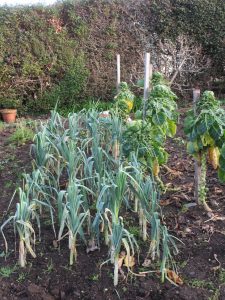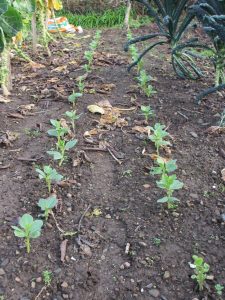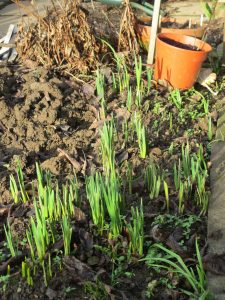January
The one thing I have learned over the years with gardening is that there is always something to do! Even in January! Once the excesses of Christmas are over and life returns to whatever you regard as ‘normal’, then that is the time you can look at your garden and start to think about what can be done.
Then of course there is the digging! If you haven’t started already now is the time to bend that back and start turning the ground. I have a friend who keeps horses and now is the time I pay her a visit to bag up some of that well-rotted by product of this occupation. Being well rotted is the key as it a lot easier to dig in, and believe it or not it doesn’t smell when you bring it home in the car! It won’t be that long before you start to think about your early planting, and it’s always good to have soil turned and weathered when you make that decision.

Leeks in January
The other beneficiaries of the digging are the local wildlife. I never cease to be surprised how unconcerned the Robins are, and how close they come when you start to turn up the bugs and worms. I love watching the blackbirds collect multiple worms in their beaks as they bounce around the freshly turned soil!
Another job for January is the pruning of the apple trees. Cutting back the long spindly shoots and keeping the trees aired will repay you with a bountiful crop in the summer – and it will look a lot tidier! I also spray my raspberry canes and gooseberry and currant bushes with a tar oil spray which you can’t get anymore. So next year I will have to find an alternative.
I seem to be planning ahead this year as I have already bought my seed potatoes! So it won’t be case of just buying what is left when I actually get round to it. Each year it seems to become more and more difficult to decide what to buy as there are more and more varieties on offer, and they all have their different attractions. A few years ago I grew some blue potatoes which actually stayed blue on cooking which certainly drew some comments at the meal table! This year I decided on ‘Winston’ for first earlies, as I grew them quite successfully a few years ago. I am a great fan of ‘Charlotte’ for second earlies, but this year I have been very brave and will be trying a variety called ‘Nicola’’ which has had some very good reports. They have all been laid out in a tray for ‘chitting’ so we wait and see.

Autumn-sown broadbeans
I have also bought my shallots, which of course will be one of the first things to plant, as, weather permitting, you should get them in the ground in February. This year I am growing one of the many French varieties on the market; ‘Vigamor’ which I grew quite successfully last year. They also seem to keep quite well – as I still have some in the larder!
Being so well organised this year I have also sent in my seed order. Being a member of the local Horticultural Society meant I got a 50% discount from Suttons Seeds which is a good deal in anybody’s book! What magic in a packet of seeds – it never ceases to amaze me!
Other tasks I have to consider for the immediate future include changing the soil in the greenhouse border (this reduces the risk of virus build up in the soil), cleaning the greenhouse, buying some onion sets and starting to plan where I am going to plant things. Using the same ground year after year it is important that you practice rotation so that the same plants to do not grow in the same place every year.
The other principle I have to remember is not to be too keen and enthusiastic! I have lost quite a few early sowings from putting them in when it was too cold. Quite often in Devon we are lulled into the sense that spring is coming with some nice mild weather, when suddenly it gets cold again and we get late frosts. One gnarled and ancient gardener (which is a bit unkind about my neighbour!) said to me once ‘Wait for the weeds and then plant your seeds’ – which I thought was actually quite a sensible statement.

Yes – spring is coming
And then of course there is the digging …
Maurice Bard

Great article, Professor Bard, thank you.